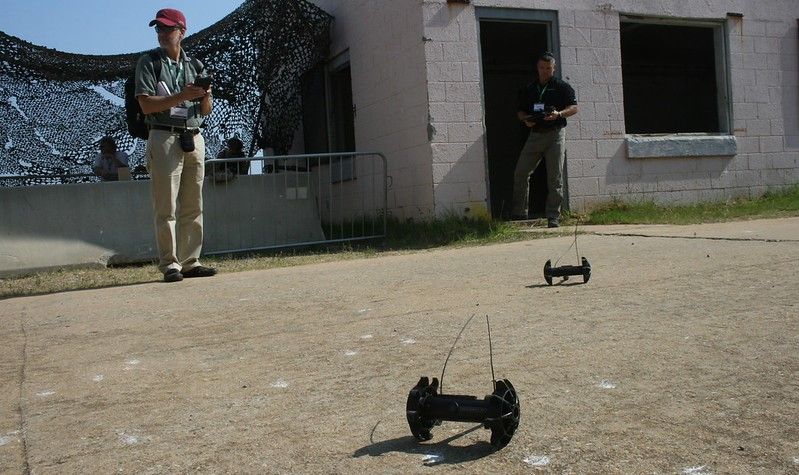A Vision of the Robot Wars of Tomorrow
US military testing of a combined human-drone-robot offensive gives a glimpse of what next-generation combat will be like.

Ever since the earliest science-fiction novels were written, the idea of mechanical fighters has been a shared outlook of how future combat would be.
With drone technology advancing at an incredible pace in the sky, on the water, under the water, and on land, the futuristic concept of robots fighting each other is turning into reality. A future that today’s military commanders hope will reduce human casualties.

Without AI involvement, current robot designs still have a human making all the decisions - just one that is placed out of harm’s way - while robots and drones scout ahead. There they identify risks, destroy enemy strongholds, and provide covering fire and real time surveillance for human ground troops who can then enter a much safer area.
It is a plan for low-risk combat, as by promising to send remote-controlled robots into the most dangerous situations Gen. James Rainey, who heads up the US Army’s Futures Command, believes that, “We will never again trade blood for first contact.”
But more than just being a battlefield advantage, the need to research and develop warrior robots and advanced drone systems is essential, so as not to be left behind in the arms race. With highly technical China a possible adversary in any future war, the US military is keen to be the first to ground-breaking hardware in this field.
“[If] we will fall radically behind,” says Alexander Miller, who is now serving as chief technology officer to Army Chief of Staff Gen. Randy George, “there are bad people who are willing to use robotics, and if we don’t figure it out we will be behind the curve, we will put men and women in harm’s way.”
For this reason, the Pentagon is trying to put the latest technology into the hands of troops on the ground for testing and use, as soon as is practical.
“The pace of the threat and the pace of technology — the evolution is much faster,” explains Joseph Welch, the Army’s C5ISR Center director. “There’s no way that we’re going to succeed if we continue to acquire technology or even choose to develop [it at a standard pace].”

For this reason, and for the first time, the Army has included funds for researching robotic armaments (with a total $33 million requested) in the 2025 budget outline to Congress.
Called H-MIF, the program is a human-machine integration capability for use with both infantry and armoured vehicles. A program with an over-arching vision to ‘off-load risk’ and provide field commanders with ‘additional information for decision making.’
You might also like to read: Speedy Drone Development Too Much for Military Procurement or Red Sea Drone Attacks Highlight Urgency for Laser Weaponry
The latest and largest test, named Project Convergence, gave an insight of what a future combat zone would look like by deploying more than 240 pieces of hardware from the US, and its allies, the UK, Australia, Canada, Japan, and France. Filling the mock-battlefield with robots, drones, sensors, counter-drone systems, jamming devices, and even a “ventriloquist decoy emitter that emulates radio frequency traffic to confuse the enemy”.

It is a scene witnessed and perfectly described by Jen Judson, a reporter and military analyst at the journal Defense News. “Looking like a toy helicopter, a small black drone rose up over a cluster of adobe buildings in a quiet desert village, emitting a faint buzz,” writes Judson. “The drone, an Anduril Industries’ Ghost-X, paused and then rose higher, disappearing into the clouds. Another followed.
“Seemingly small and unthreatening, the drones were serving as the eyes of an infantry company concealed by the surrounding mountains and readying to reclaim a village held by the enemy.
“And those drones were not alone.
“All at once, an overwhelming group of air- and ground-based machine fighters burst onto the scene. An ‘octocopter’ lumbered through the sky with precision munitions and other robots attached to its belly, dropping three 60mm mortar rounds on a roof and other small, hand-held, cylindrical ‘throwbots’ on the ground.

“Robotic combat vehicles rolled into view, armed with .50-caliber and M240 machine guns, firing on enemy positions and providing cover for troops maneuvering into the village.
“Meanwhile, a four-legged dog robot stepped out from a thick cloud of smoke, giving the soldiers monitoring from afar another view.”
At one point during the battle simulation, Judson observed how the Army testers intentionally jammed one of its own drone swarms, causing it to fall to the ground. But the commanders, prepared for what will be a new battlefront in controlling the airwaves, quickly fixed the problem by turning on a smart routing capability that reconnected the robots to the Wi-Fi.
It is a drill which showed some of the challenges soldiers in a future war will face, and the problems that military hardware developers are trying to solve today.
“[The experiment itself illustrated] just how complicated it’s going to be,” says Miller. “Where we really proliferate lower-cost, cheaper options and we clutter the environment intentionally.”

For some, the idea of man against machine is horrific, for others it is a necessary technological advance that will stop the good guys from dying at the robotic hands of their enemies.
At least for now, the technology is still largely human controlled. It might be a robot firing the machine gun, but it is being operated by a human from hundreds of metres (or miles) away.
The really scary vision of future combat come with the advance of autonomous robots - fighting machines that make their own decisions. Perhaps when that happens, and it will happen one day, it will then be time to think about pulling the plug.
Photo credit: Flickr, Wikimedia, Nara, Flickr, Alin Constantinescu from Pixabay, & vector_corp on Freepik

